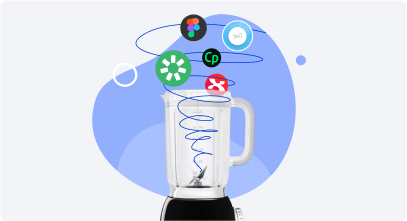The Best 10 eLearning Authoring Tools & Software

Do you know that the authoring software market is expected to reach in $2.5 billion by 2028? Given that the field is highly competitive, and eLearning authoring tools abound, it can be challenging for teachers, instructors, freelancers, and corporate training specialists to make a good choice based on functionality, ease of use, tech support, and price altogether.
We’ve selected and tested the 10 best eLearning authoring solutions, analyzed their main selling points and compared pricing to help you find the best authoring tool. Below are the highlights of each authoring tool for your convenience.
- iSpring Suite – a PowerPoint-based eLearning authoring tool for those who need to create versatile eLearning content fast, with no previous experience in course development and special training.
- Adobe Captivate 360 – a professional-level authoring tool for seasoned instructional designers who want to create complex software simulations and VR learning experiences.
- Articulate Storyline 360 – a robust eLearning authoring tool that has numerous content creating capabilities, but requires a lot of time to master all of them. It is best suited for experienced course developers who need advanced features like triggers and layers.
- Articulate Rise – an intuitive eLearning authoring tool that allows instructional designers to create responsive online learning content in the “longread” format using their browsers.
- Camtasia – an eLearning authoring tool with a drag-and-drop interface that has everything you need for creating video tutorials that can act as training materials.
- Lectora Online – a powerful, yet complicated eLearning authoring tool that allows extensive customization via programming code, external libraries, and scripts; more suitable for well-trained developers.
- Elucidat – a cloud-based eLearning authoring tool that allows you to create online courses with pre-built templates; a good fit for organizations with dispersed L&D teams.
- Coassemble – an eLearning authoring tool that combines an authoring tool and LMS functionality.
- Gomo – an easy-to-use web-based eLearning authoring tool that comes in handy for collaborative eLearning projects.
- H5P – is an open-source eLearning authoring tool designed for creating a variety of interactive educational activities right in a browser.
What Are eLearning Authoring Tools?
eLearning authoring tools are software used for creating content for online learning and training. They allow for producing instructional content in certain digital formats, or eLearning standards: SCORM, TinCan (xAPI), AICC, cmi5, and HTML5. Learning content created with authoring tools is usually delivered via a learning management system (LMS), or in a browser (in HTML5 format).
Desktop vs. Cloud-based authoring tools
From a technical point of view, all eLearning authoring tools can be divided into two major groups: desktop and cloud-based tools. Each of the groups has its own peculiarities and impacts course authoring in a certain way. Let’s take a closer look at both types of authoring tools.
Desktop tools
Desktop authoring tools have a longer history and remain the most trusted option for creating digital learning content. They typically have a more advanced set of features, including branching, extensive customization, or simulated experiences. Currently, best authoring tools on the market tend to have a core desktop tool and an additional online collaboration tool that works in a cloud.
Desktop authoring tools can be accessed on different computers, but this will require purchasing several licenses. Users store all data on their machines and need to perform backups to protect training materials.
Cloud-based tools
Cloud-based software enables content creators to access their eLearning projects in a web browser, collaborate on the training material in real time and make amendments to the content seamlessly. Tools like these have a familiar ‘app style’ web interface and enable lightweight content creation with pre-made content templates and multimedia.
Cloud-based eLearning authoring tools require internet connection but provide a greater flexibility in terms of access to content. This is great both for team work on corporate eLearning content that typically involves many stakeholders and for sharing training courses with associated instructors or learning audiences. All your data will be the stored on the provider’s cloud hosting, with minimal security risks.
In the search for the right eLearning authoring software for your needs, you need to keep in mind the complexity of IT implementation and security requirements. In case you consider a cloud service, make sure you know the following:
- Does your corporate network security policy allow data to be stored on external severs?
- Where are your vendor’s servers are located, and can you use them or not?
10 eLearning Authoring Tools to Consider – the Comparison chart
Now let’s take a detailed look at 10 top-performing eLearning authoring tools on the market in 2023. But before we get into the details, check out this handy comparison table to get an overall picture of what to expect from each of the authoring tools.
| Authoring tool | Type of solution | Learning curve | Collaboration capabilities | Publishing options |
| 1. iSpring Suite | Content authoring suite | Low | Yes | HTML5, Video, SCORM (1.2, 2004), xAPi/Tincan, AICC, cmi5, HTML5 |
| 2. Adobe Captivate | Standalone authoring tool | High | No | HTML5, SWF, SCORM (1.2, 2004), AICC, xAPI, Exe |
| 3. Articulate Storyline 360 | Content authoring suite | Medium | No | HTML5, Video, SCORM (1.2, 2004), xAPi/Tincan, AICC, cmi5, MP4, Exe |
| 4. Articulate Rise 360 | Web-based authoring tool | Low | Yes | HTML5, PDF, AICC, SCORM, xAPI, cmi5 |
| 5. Camtasia | Video authoring software | Medium | No | SCORM (1.2, 2004) |
| 6. Coassemble | Online training platform | Low | No | SCORM, Online link, xAPI |
| 7. Lectora Online | Web-based authoring tool | High | Yes | ReviewLink, HTML5, Tin Can |
| 8. Elucidat | Web-based authoring tool | Medium | Yes | SCORM, Online link, API integration |
| 9. Gomo | Web-based authoring tool | Low | Yes | SCORM (1.2, 2004), xAPI |
| 10. H5P | Open-source authoring tool | Low | No | Link in iframe, LTI |
1. iSpring Suite

iSpring Suite is the best eLearning authoring tool for Windows that makes course creation easy and intuitive. A major plus with iSpring is that it works as a PowerPoint integration and has a familiar WYSIWYG interface that’s very easy to use. You can start with an existing PowerPoint presentation and enhance it with more sophisticated eLearning content, like interactive quizzes, video lectures and screencasts, or role-plays with branching.
To create beautiful courses even faster, there’s Content Library, filled with high-quality images of location backgrounds, icons, controls, and characters (available in the iSpring Suite Max package).

In addition to the ready-made characters, you can create and use your own: pick one from Content Library and customize their clothes, accessories, and hairstyle. Add some culture-specific elements or workwear and choose the preferred pose. You can also save your character for future courses.
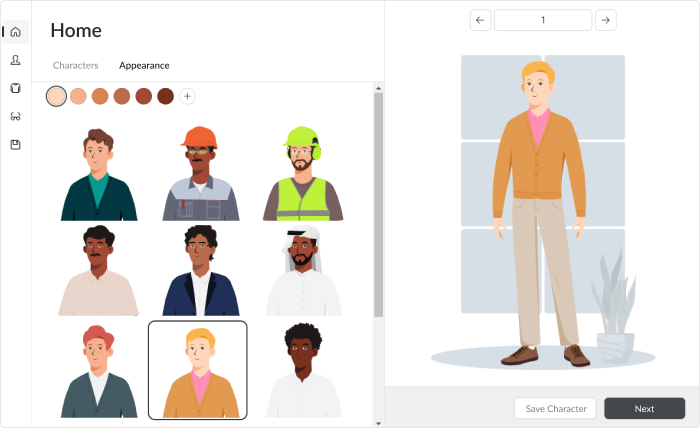
In iSpring Space, an online space for teamwork on eLearning projects, you can collaborate with other authors on learning courses, review the content or edit texts, add knowledge checks, and polish the course look and feel in real time.
Platform
Windows
Output options
- pure HTML5
- MP4 for video
- eLearning formats – AICC, SCORM, xAPI, and cmi5
Pros
- PowerPoint-based authoring toolkit
- Intuitive user interface for building courses quickly
- Built-in dialogue simulator with branching conversation scenarios
- Professional video studio for recording and editing screencasts and webcam footage
- Robust tool for creating interactive quizzes and surveys
- Perfect playback on mobile devices
- Text-to-speech function
- Ability to turn PPT presentations into SCORM courses
- Ability to convert Word and PDF documents into interactive SCORM flipbooks
- Professional grade content library with 89,000 design assets for employee training courses
- Cloud service for fast content sharing and collaboration
- XLIFF Translation support for fast course localization
- The Character Builder for creating custom characters
Cons
- PowerPoint needs to be installed for iSpring Suite to work
- Doesn’t support closed captioning (CC) for video and audio narration
- No software simulation support
- Only works on Windows
Best for
iSpring Suite is a fast eLearning authoring tool, and a great pick for Microsoft PowerPoint users looking to take the leap into full-fledged course creation. If you already have PPT presentations, you can turn them into eLearning courses in just a couple of clicks.
You can also publish your Word and PDF documents to eLearning formats quickly and efficiently. The result will be interactive e-books with a realistic page flip effect. When you want to get more creative and add quizzes, dialogue simulations, and interactions, there’s plenty of power under the hood.
Pricing
$970 (Annual license)
2. Adobe Captivate
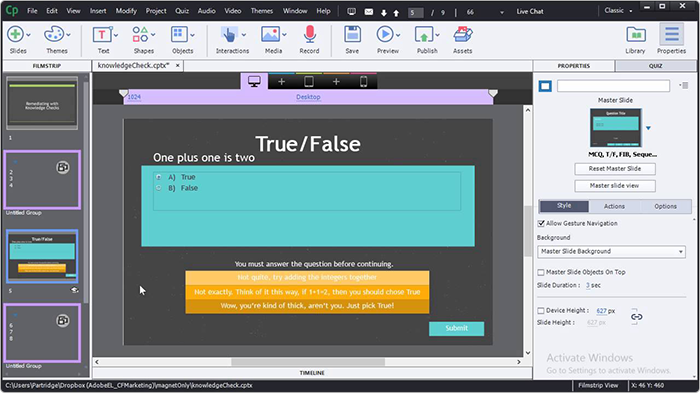
Adobe Captivate is a powerful authoring tool that’s well suited for general eLearning development such as creating slide presentations or quizzes and developing complex interactive courses. Also, it’s traditionally a preferred choice for creating software simulations with the help of effects, triggers, and slide settings. Adobe Captivate allows for a lot of versatility in creating realistic simulations and presenting them to users in different modes, ex.: see it, try it, do it.
A standout feature of the latest 2019 Captivate release is the ability to create Virtual Reality projects and make interactive videos and studio-quality HD videos by simultaneously recording webcam and on-screen content and adding interactive elements. The wide range of interactions are another strong point of this eLearning authoring toolkit. You can make eLearning fun with drag-and-drop exercises, puzzles, games, and other interactive activities – all of them will be perfectly displayed on mobile devices as well.
Platform
Windows and Mac
Output options
- HTML5
- eLearning formats – SCORM, AICC, and xAPI
- Flash (with an option for creating lessons in the EXE format)
Pros
- Extensive variables and branching that allow creative customization
- 360-degree (VR) capability to embed virtual reality into your eLearning
- True responsive screen display on all devices, viewable as you create the training
- Asset library that includes templates, people, headshots, and full-body shots
- Ability to generate text-to-speech (TTS) voiceovers automatically
- ‘Green screen’ feature where you can insert your own background
- Mobile-specific development tools such as geolocation tagging
- Complex software simulation recording options
- Has a version for Mac
Cons
- Unintuitive user interface
- Steep learning curve: it takes hours to learn the course creation process
- Customers report that Captivate can get buggy and crash on Windows
- Designing responsive content is difficult, since you have to create separate versions for desktop, tablet, and smartphone
- Imported PowerPoint presentations don’t preserve all their animations after being converted with Captivate
- Technical support outsourced to a call center
Best for
Adobe Captivate is professional eLearning software, less easy and intuitive, but more powerful than its competitors. This course authoring tool is best suited for experienced eLearning developers who are comfortable working with variables and some coding to make the magic happen.
In contrast to some vendors that offer an LMS or hosting solution as part of the package, if you want to host the courses that you author directly via Captivate, you’ll need to purchase the PRIME package, which is more expensive and probably not suitable for small organizations with less than 100 employees.
Pricing
$33.99/month or $1,299.00 (Perpetual License)
3. Articulate Storyline 360

Articulate Storyline is the flagship desktop authoring tool by Articulate. Storyline comes bundled with a few other applications like Rise and Review when you purchase an Articulate 360 subscription.
Storyline is popular in the instructional design community since its advanced feature set includes triggers and layers that allow creators to go above and beyond in producing customized training content. However, for a newbie, it would pose a serious challenge to get to grips with Storyline – there aren’t many built-in interaction templates, so one would have to spend time learning how to create them from scratch.
With Storyline comes the Articulate Content Library – a collection of course templates, backgrounds, characters, buttons, and icons. It includes a rather small portion of visual assets created specifically for instructional design, at the same time providing access to a vast collection of stock images.
Platform
Windows
Output options
- HTML5
- eLearning formats – SCORM, AICC, xAPI, and cmi5
Pros
- Similar to the PowerPoint interface of Storyline 360, but with greater opportunities for customizing the content
- Allows you to build complex interactions by utilizing features like object states, triggers, and layers
- Screen recorder for making screencast captures and simple editing
- Content library with access to stock images
- Responsive courses for mobile learning
- Can import PowerPoint slides
- Free mobile app for playing courses offline
Cons
- Not the most user-friendly interface
- Has a rather steep learning curve
- Interaction templates sometimes don’t work properly
- Screen recording functionality is basic compared to other solutions
- Can be heavy on computer resources
- No Mac version
Best for
Articulate Storyline is best suited for experienced instructional designers who need more leverage over the learning courses they produce. This can be achieved by utilizing the advanced features like triggers and layers that Storyline provides.
Since Storyline comes with several desktop and web authoring tools aimed at making it easier for teams to collaborate on eLearning projects, it would be a good fit for collectives. The drawback is that most individual course creators and small organizations won’t need all of these tools, but will still have to purchase the entire set just to get Storyline.
Price
$1,299/year (for teams) or $999 (for individuals)
Also read: Adobe Captivate vs Articulate Storyline 3 vs iSpring Suite
4. Articulate Rise 360
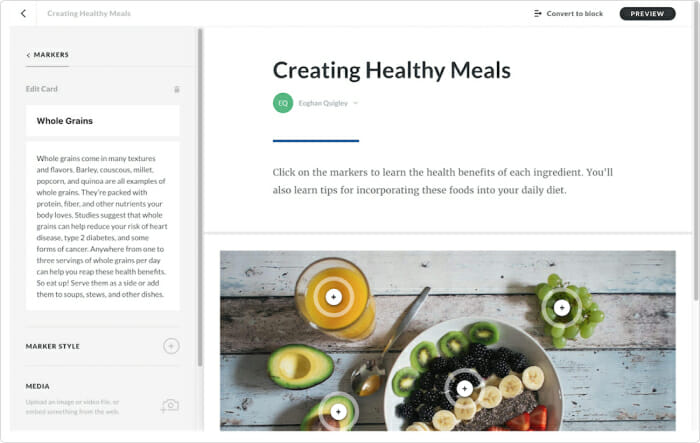
Articulate Rise is a web-based authoring tool that allows instructional designers to create training modules or entire courses in the “longread” form using their browsers. Although originally limited to a fairly small selection of interactions, Rise gets updated regularly, so more and more assets become available for course creators over time.
Platform
Windows, Mac, Linux
Output options
- HTML5
- eLearning formats – SCORM, AICC, xAPI, and cmi5
Pros
- Ability to create responsive training content quickly with a simple web interface
- Access to content library with lots of visual assets like backgrounds and characters
- OS agnostic: works on Mac, Windows, and Linux
- Support for all major eLearning standards allows one to create training content quickly and upload it to any LMS
- Allows you to collaborate on courses with your team members
Cons
- Limited content customization capabilities – an understandable tradeoff of a streamlined web application
- Only a single format of a training module (longread) can be created with it
- Just 4 types of quiz questions
Best for
Articulate Rise will be an equally good fit for new instructional designers and experienced users. When your projects don’t have strict requirements on what they should look like and how they should function, Rise will allow you to pump out training courses quickly.
Price
$1,299/year (for teams) or $999 (for individuals)
5. Camtasia
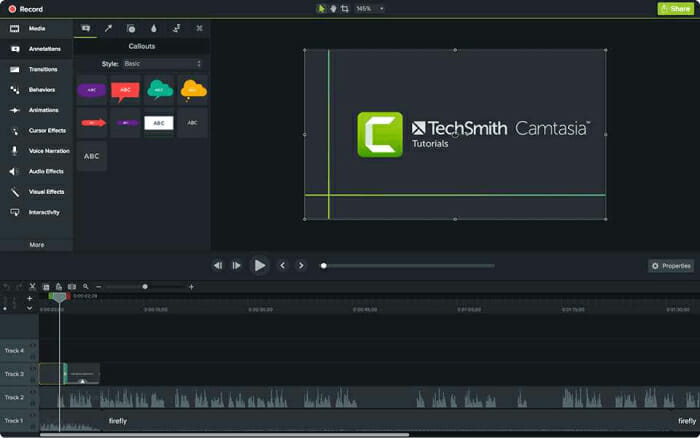
TechSmith’s Camtasia is a desktop powerhouse for recording and editing instructional videos. This eLearning authoring toolkit is available for both Mac and PC, and is considered to be one of the most popular content authoring tools for screencasts and other types of training videos. It doesn’t just allow for screen recording and editing the captured video – there’s a quiz editing tool, a bunch of stock video/audio, and various visual effects, all at your fingertips.
Platform
Windows, Mac
Output options
- video formats, including MP4 and AVI
- eLearning formats – SCORM 1.2 and 2004
Pros
- Available for both Mac and PC
- The most advanced video editor compared to all other authoring tools on the market
- Gives access to a library of stock music, intros, transitions, and other assets that will help you get the job done in less time
- Built-in quiz maker that allows you to create quizzes inside your training videos
- Supports SCORM; can export training modules for use in an LMS
Cons
- Limited to producing video content
- No interactive elements can be used in output content aside from quizzes
- Built-in quiz tool only has 4 types of quiz questions to select from
- Not half as capable as true video editors like Adobe Premiere Pro or Davinci Resolve
Best for
This eLearning software will come in handy for anyone who makes training content about computer software. Recording the screen and the webcam, editing the output with a bunch of stock effects, exporting the finished lesson to SCORM – Camtasia is a suitable authoring tool for making video tutorials. However, if the project you’re working on requires something other than a screencast with visual hints and annotations, it’s better to consider other eLearning tools.
Price
Lifetime license + one year of updates for $299
6. Lectora Online
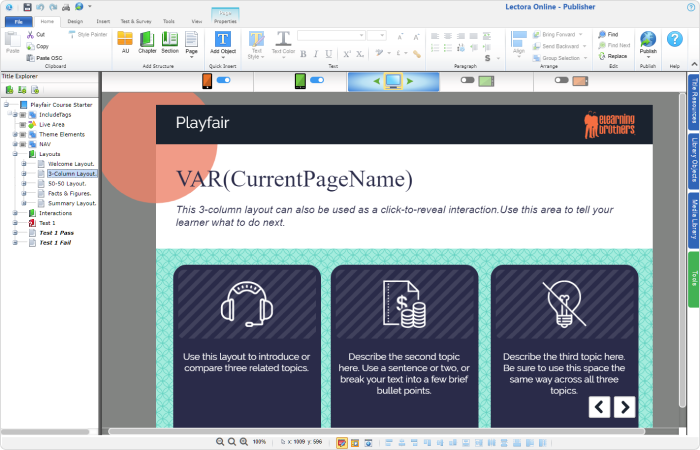
In this comparison, we’ll look at Lectora Online, the cloud-based version of Lectora Inspire, which offers content authoring plus similar eLearning development tools that are comparable to the other products in this article.
A big focus of the Lectora product range has always been compliance with web content accessibility guidelines (WCAG). This ensures that any course created with this online eLearning tool will be accessible to those with disabilities, such as hearing or vision impairment. If you work in or develop content for federal government organizations, this authoring software is a good choice.
Lectora’s popular Getting Started templates are a great shortcut for course authoring. Each template includes built-in navigation, interactive samples, page layouts, and instructions for use. Plus, these built-in templates offer different learning styles and course types such as basic linear, non-linear, microlearning, scenario-based, adaptive, time-of-need/just-in-time training, multimedia, and more.
For more experienced users, Lectora Online supports scripts, custom libraries, fonts, and CSS, so the sky’s the limit in terms of customization.
Platform
Cloud-based
Output options
- HTML5
- eLearning formats – AICC, SCORM, and xAPI
Pros
- WCAG compliant
- Supports conditional branching and sequenced events
- Ability to add your own scripts, custom libraries, fonts, CSS
- Built-in versioning for collaboration
- Robust quizzing options
- Getting-started course templates that include navigation and sample interactions
- Global content management and update of assets
- Reviewing integration with review link
- Stock images and templates from eLearning Brothers
Cons
- More expensive than its competitors
- Clunky, outdated UI
- Not the most intuitive authoring tool on the market
- Advanced features don’t support Section 508
- In order to create a responsive course, you need to edit the same content in 5 (!) different views
Best for
Lectora has a legion of fans, but they mostly fall into the ‘power user’ category, meaning they’ve spent considerable time learning to use this authoring tool and are truly experts with it.
Lectora doesn’t offer a user experience as clean as e learning authoring tools like iSpring Suite and Articulate Rise, but certainly offers a great degree of power and flexibility for experienced and more technically inclined eLearning developers.
This authoring software is most suitable for larger and geographically dispersed organizations with a mature L&D model and content creation processes that encompass multiple authors and reviewers.
Pricing
$500/year (Starter), $900/year (Pro), $1390 (Team)
7. Elucidat
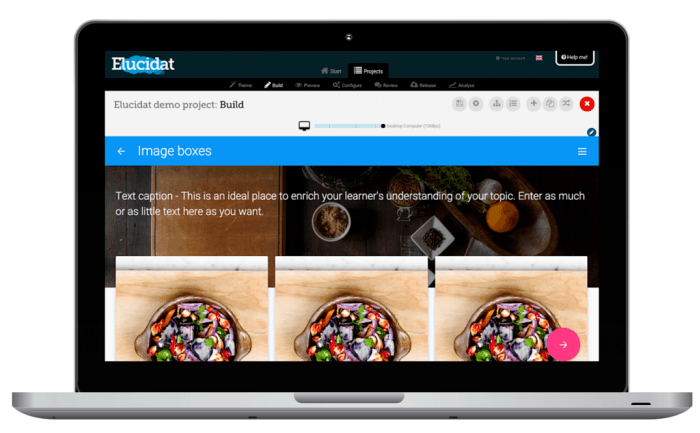
Elucidat’s cloud-based authoring tool lets you produce responsive SCORM-compliant eLearning content that they claim will work with any modern LMS.
This online course authoring software enables a whole team, from content designers to subject-matter experts, to review and contribute to the course authoring process at any time.
Elucidat aims to be an all-in-one cloud-based authoring tool for creating high-quality eLearning, managing online training resources at scale, and analyzing performance. It has all the features you’d expect from an authoring software: templates, resources, video and audio management, a mobile responsive editor, a layout designer, and more usual elements like buttons, flip cards, and input boxes.
There’s also a focus on collaboration with multiple course authors, and powerful features for role-based development and translation projects across multiple regions. These include separate modular views for team leaders, SMEs, designers, and reviewers, who can get access to a feature set relevant to their roles and position in the development process.
Platform
Cloud-based
Output options
- HTML5
- Video
- eLearning formats – SCORM (1.2, 2004) and xAPI (TinCan)
Pros
- Management of eLearning content at scale
- Streamlined workflows for teams
- Page transition effects
- Ability to create single courses that are responsive on any device
- Personalized learner clips
- Flexible item animation; it’s possible to animate almost any course element
- Easily access data and insight into how users engage with learning content
- XLIFF Translation support for automatic course localization
Cons
- You have to store all your contents on the vendor’s servers
- Lacks flexibility in comparison to other toolkits, so experienced content authors may find themselves limited in their abilities
- Doesn’t give too much control over custom interactions in your content
- Can get more expensive than any of its competitors according to user reviews
Best for
Elucidat is well suited to organizations with dispersed L&D teams and requirements to deliver course variations by locality.
Elucidat allows an author to create a central “master course”, which has full control over its “child courses.” Once an edit is made to a master course, the child course will then follow — edits can still be made locally in a child course. Elucidat users can manage several course variations within one location, saving the hassle of creating numerous versions and editing each one individually.
Price
No price listed; you need to contact the vendor.
8. Coassemble
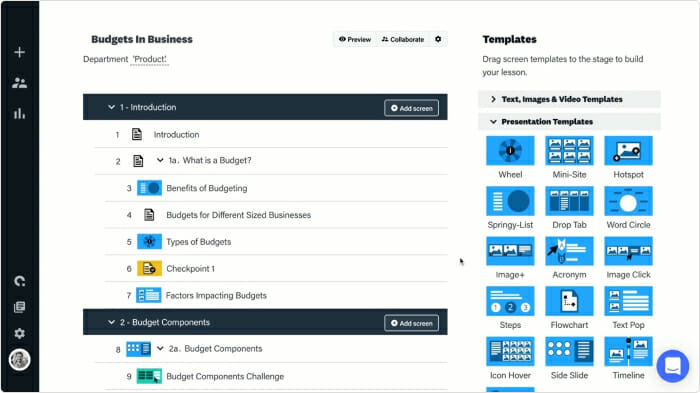
Coassemble is a cloud-based authoring tool + a learning management system with capabilities of the former, similar to those of Articulate Rise. It enables users to pick one of 10 ready-made templates in the longread format and fill it with text and multimedia content like images, video, and quizzes. There’s a surprising variety of interactive elements that can be added to your course content: from simple slide sequences to timeline and label images. Learning courses can then be assigned to students through the Coassemble LMS.
Platform
Cloud-based
Output options
eLearning formats – SCORM, xAPI
Pros
- User-friendly interface
- 8 question and 16 interaction types available
- Hosted in the cloud – you can author course content from any platform or location
- Can import SCORM modules to add them to your online courses
- The product is also an LMS, so finished modules can be assigned to learners right away
Cons
- No dedicated mobile app for taking courses on smartphones
- Interface looks clunky and poorly designed on certain screens
- Just a few templates available when you start a new course – would like to see more in the future
- SCORM can only be exported as a link to Coassemble’s server
Best for
Coassemble will be an interesting authoring software to try for small teams that need to start training their employees as soon as possible. The combined authoring tool + LMS functionality ensures that, as soon as a new course is ready, it can be put to good use and shared with learners. Of course, there are some limitations that stem from the web nature of the app, but the extended selection of interactions and question types will make up for it, making the training process engaging.
Price
Several plans, starting from $490/year
9. Gomo
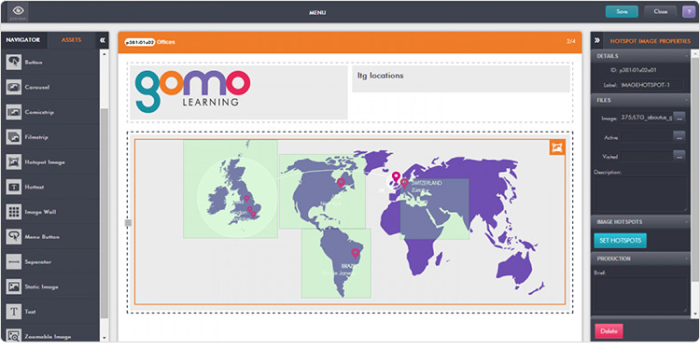
Gomo is another cloud-based authoring tool that allows you to create online courses that learners can view online from a website or through the Gomo app. It was designed with teams in mind. This tool is perfectly suited for collaboration on content – multiple users can edit the learning content and leave notes for each other in real time.
The course development process is based on using ready-made templates and themes that can be configured to suit your project or brand. You just need to choose the templates, compliment them with text and images, set up the feel and look of your course, and it’s ready to go.
Platform
Cloud-based
Output options
eLearning formats – SCORM (1.2, 2004) and xAPI
Pros
- Hosted in the cloud – you can create courses right in your browser
- Ability for team collaboration on the content
- Branching scenarios
- Simple course structure overview
- Pre-built themes with customization options
- Easy-to-use image editors
- Centralized resource library
- XLIFF translation support for creating localized content
Cons
- Fewer customization options than some competitors offer
- You have to store all your materials on the vendor’s servers
- No mobile app for taking courses on smartphones
- No video capture tool
- Some users report that the tool is a little slow in some processes
Best for
Gomo is an easy-to-use authoring tool that is ideal for collaborative eLearning projects. It is one of those training tools that have enough basic functionality to allow the building of a simple eLearning course with quizzes. However, if you need to create versatile and more sophisticated learning content, this authoring tool may not be the best solution.
Due to its multi-language and localized content options, the authoring tool will also be a smart choice for large enterprises that want to translate courses into multiple foreign languages with minimal time and effort.
Price
No pricing options listed; you need to contact the vendor.
10. H5P
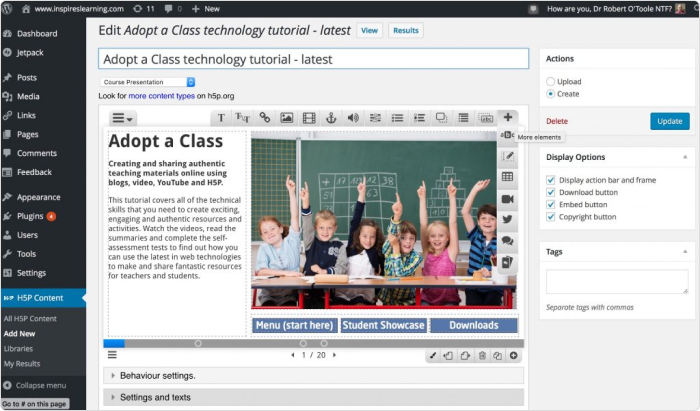
H5P is an open-source authoring tool developed for the creation of interactive educational activities right in a browser. You can make interactive videos, course presentations, crossword puzzles, pairing memory games, and more. More than forty types of interactive learning activities are available.
There are three ways to use H5P. The first is with plug-ins on WordPress, Drupal, and Moodle. In this case, it will be a free eLearning authoring software. The other ways are using a direct link and adding the activities to any platforms, blogs, and other sites that support embedded content, or delivering the content to learning management systems like Canvas, Brightspace, Blackboard, Moodle, and other systems that support the LTI standard. The latter services are provided via H5P.com and require a paid subscription.
Platform
Cloud-based
Output options
Link in iframe, LTI
Pros
- Web-based – you can create eLearning courses in your browser
- There’s a free version
- Extremely intuitive
- A variety of interactive learning activities
- There’s an open educational resources hub where authors can collaborate and share open content
Cons
- Doesn’t have the versatility of other paid elearning content authoring tools
- Ability to import the content only to LMSs that have LTI
- Reporting is only available with a paid subscription
- No screen recording or video editing tool
- No preview option
Best for
H5P is a great starter option if you’re just taking the first small steps in the content authoring sphere, or if you don’t have the budget to invest in top eLearning authoring tools. Despite the authoring tool allowing you to create a variety of activities, its functionality is quite limited in comparison to best eLearning authoring tools.
However, if you work with educational institutions and use Moodle LMS, H5P can be an effective free eLearning tool to create engaging interactive, mobile responsive content for your students.
Price
Free with plug-ins. The paid subscription starts at $804/year for 3 authors and 250 learners.
Also read:
- Best eLearning Platforms to Drive Corporate Training
- SCORM Compliant LMS: How to Find an LMS That Checks All the Boxes
- Best 20 Explainer Video Software for Every Budget and Skill Level
- How to Create a Moodle Quiz: Step-by-Step Guide
To Sum Up
We hope you found this roundup of most popular authoring tools useful and are on your way to selecting an ideal eLearning authoring tool.
Sign up for a free trial of each authoring software you’re interested in, use various eLearning authoring tools, and make sure you enjoy it. If your authoring experience is causing you problems and forces you to deal with technical issues instead of making great learning content, consider another course creation tool.
If you want to produce eLearning courses right out of the gate without spending hours training or reading support forums, start with an iSpring Suite 14-day free trial and explore all its features right now.





